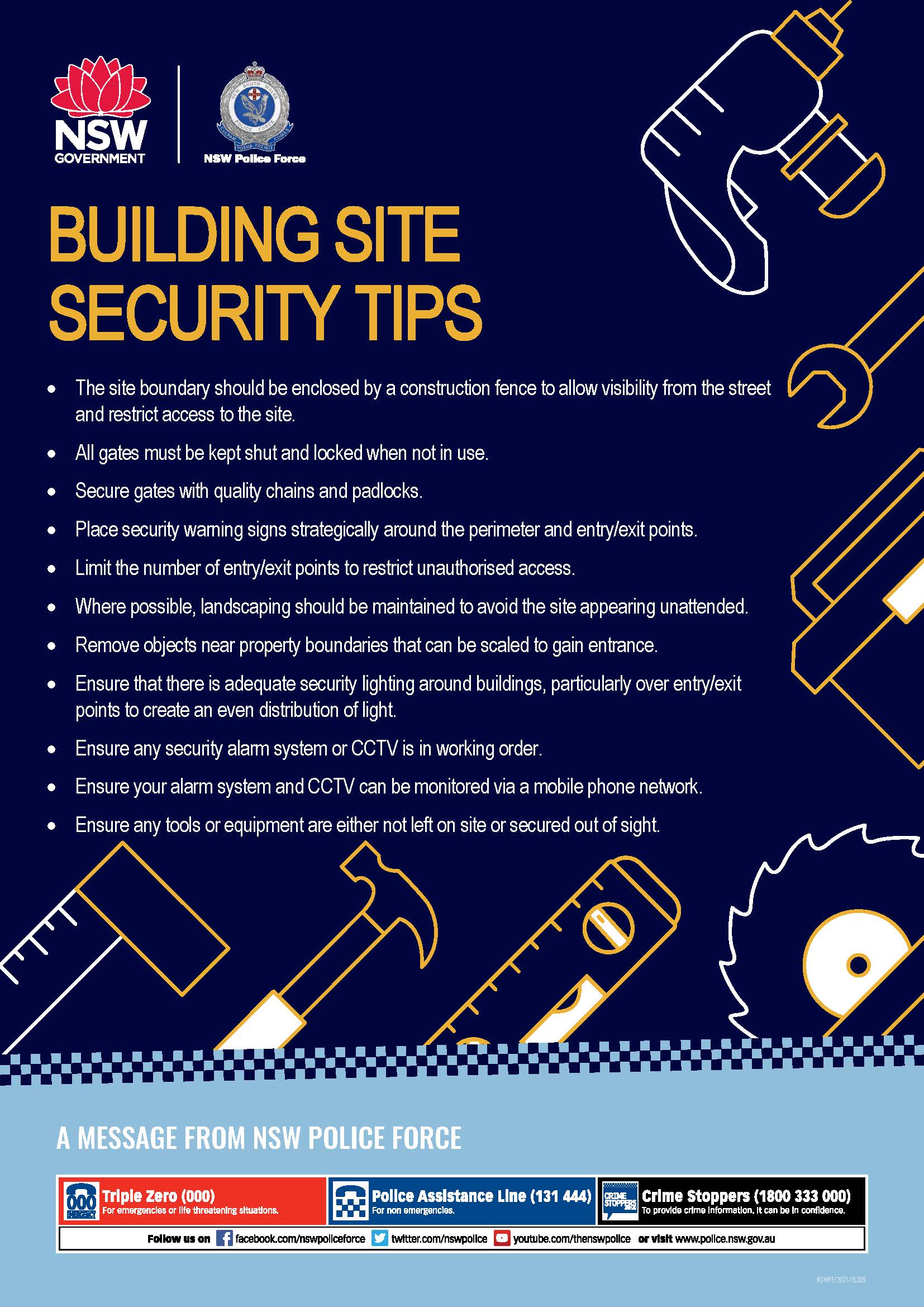Just as there are risks to you in personal and public life, your working life or businesses are susceptible to acts of crime. It is important to identify where your business may be vulnerable to crime and how you can protect it.
Break-ins
- Display the street/shop number and business name at the front of the business to assist emergency services locate the property;
- Post warning signs around the business to warn intruders about the security features you have in place;
- Remove obstacles and rubbish from property boundaries, footpaths, driveways, car parks and buildings;
- Install security lighting around the perimeter of the business, particularly over entry/exit points;
- The doors, walls, floor and ceilings of the building should be of solid construction. Limit the number of entry/exit points to restrict unauthorised access;
- Doors should be fitted with quality single cylinder dead lock sets to comply with the Australian Building Code, fire regulations;
- Glass within doors and windows should be reinforced with either a shatter resistant film or laminated glass;
- Record descriptions, models/serial numbers of property owned by your business;
- If your business deals in cash then you should consider the installation of a safe to provide additional security. The safe should be manufactured and installed to the Australian and New Zealand Standards and should be anchored to restrict removal;
- Limit the amount of money you hold in the cash drawer. Don’t count money in public view;
- Have a monitored intruder alarm system installed to enhance the physical security of your business;
- All ATMS should be placed away from entry points of your shop. They should be anchored to the ground and covered by way of CCTV.
Fraud
FRAUD - WHAT IS IT?
Fraud is defined as encompassing a wide variety of corrupt, deceptive, dishonest or unethical behaviour. It is described as using false representation to obtain unjust advantages. The main types of fraud that retail and restaurant businesses are most likely to come in contact with include credit card fraud and counterfeit notes.
CREDIT CARD FRAUD.
- Be alert for customers who act suspiciously, particularly if they:
- Try to rush through a sale
- Look nervous or agitated
- Make purchases without regard to size, quality or price
- Arrive at closing time
- Have no identification
- Request transactions to be manually entered
- Sign their name slowly or unnaturally
Always inspect the card front and back:
- Check if the card is damaged
- Check the expiry date
- Check the printing and embossing - does it appear to be altered?
- Check the hologram is 3D and changes colour when tilted
- Check to see if the card is listed in the Warning Bulletin
- Check to see that the card has been signed
- Check the signature panel – has it been altered?
- Does the customer’s signature match the card signature?
If you are suspicious of the card:
- Ask for photo identification, such as a drivers licence or passport
- Hold the card while completing the transaction
- Call for authorisation and ask for “Extension 500”
Never let anyone service or remove your EFTPOS terminal without first sighting appropriate photo identification and change the terminal password or PIN regularly.
COUNTERFEIT NOTES - WHAT TO LOOK FOR!.
- Feel the note – a genuine note is printed on special plastic polymer and is difficult to tear
- Hold the note to the light and look for the Australian Coat of Arms. This is generally located to the left of the clear window, or denomination numeral when looking at the front of the note. For the $5 note, check to the left of the word ‘Australia’
- Look for micro printing. This is generally located near the portraits. Using a magnifying glass, micro-printed words should be clearly visible
- Feel for slightly raised printing on the main design of the note
- Look for the seven pointed star inside a circle
- Compare the background printing - look for any distortions or less clearly defined patterns.
- Check that the note has a clear window and that it has a clear printed image: $5 note has a gumflower; $10 has a windmill; $20 has a compass; $50 has the Southern Cross and the $100 has the lyrebird. Also, if the note is titled the embossing of a wave pattern is located in this window on the $10 and the numbers 20, 50 and 100 appear in the window of the respective notes
- If possible, Look under a UV light to locate the serial numbers
WHAT TO DO IF YOU SUSPECT THAT YOU HAVE RECEIVED A COUNTERFEIT NOTE!.
- Advise the person that you think that the note is counterfeit and that you are going to call the Police
- Handle the note as little as possible and place it in an envelope or other protective covering
- Record the person’s description and vehicle registration numbers (if sighted)
- Notify the Police straight away
BUSINESS SCAMS.
- DO business with companies you know and trust
- DON’T be rushed or pressured into making a decision or fall for high pressured sales tactics
- ALWAYS ask for the name, identification, ABN and contact number of the person you are speaking to and who they represent
- INSIST on written information and quotes for work
- FIND out whom you are dealing with. Contacting the Australian Securities and Investments Commission (1300 300 630 or 9911 2000) is a good place to start
- READ letters and contracts carefully and seek professional advice from an accountant or solicitor if unsure or significant amounts of time or money are involved
- DO NOT give out personal information over the telephone, such as credit card details or the names of employees, until you have checked out the company and know they are legitimate
- KEEP proper records. Poorly organised businesses are the main targets for scammers
- KEEP the number of people authorised to pay cheques to a minimum.
Robbery
A small amount of planning, may assist in reducing the risks of armed robbery to your store and increase the chances of prosecution of robbers. The aim of any planning in dealing with armed robbery should be for the:
* Safety ofemployeesand customers. * Reduction in the property stolen. * Early arrest of the offender.
PREVENTION
- Be alert to strangers or individuals who may be observing your business or who are asking questions about how your business runs.
- Ensure all back and side doors and windows are kept secure.
- Do not discuss cash holdings or movements of cash in public.
- Reduce cash held at counters to a workable minimum.
- Install a safe in close proximity to the cash register which is secured to a sturdy fixture or remove cash to a secure area.
- Designate safe areas and escape routes for you and your employees.
- Make use of signage and stickers both inside and outside your business promoting security measures such as; time delay locks, video surveillance and minimum cash held on premises.
- Consider the installation of additional security devices such as duress / panic buttons and Closed Circuit Television (CCTV).
- Ensure employees are aware of security and armed robbery procedures and what to do in the case of such an event.
- Lock the rear entrance if working alone, prior to delivery, employees arriving and once break up is completed.
DURING AN ARMED ROBBERY
- Try to remain calm, assess the situation, and do exactly as the offender says. Remember the number one priority is your safety, the safety of other employees and customers.
- Activate alarm devices as soon as possible, but only if it is safe to do so.
- Always remember that the offender will be nervous and tense so explain any movements and avoid any sudden actions.
- Speak only when spoken to as any conversation with the offender will prolong the incident.
- Avoid eye contact with the offender.
- Note the offender/s conversation including any indecent language, accent, nicknames or speech impediments.
- Unless otherwise ordered, continually watch offender/s making a mental note of their description especially scars, tattoos and any other prominent features.
- Observe and take note of weapons that are being used.
- Observe the direction of travel taken by the offender/s when they leave the premises.
- Look to see if a vehicle has been used and if there are any other occupants.
- Never take drastic action during the robbery and do not chase the offender.
AFTER THE ROBBERY
- Immediately telephone the Police on Triple Zero (000) (even if you have activated hold up or duress alarms), giving;
- Name and exact location of where the crime occurred including closest intersecting street and name of retail outlet.
- Date/time/nature of offence.
- Persons injured and whether medical assistance is required.
- Type of weapon used.
- Number and description of offender/s including any vehicles used.
- Direction of travel.
- Only hang up the telephone when told to do so and stay off the phone until police arrive unless you remember additional information that may be important.
- Close the premises to the public and keep unauthorised persons out.
- Make sure that no person touches or moves any items where the offender/s was / were present.
- Consider arranging someone to meet police outside, particularly in large shopping areas to make the response more efficient.
- Have witnesses and customers remain until the Police arrive – failing that, obtain their names, addresses and telephone numbers.
- Make sure witnesses are isolated from each other.
- Witnesses should independently try to write a full description of offender/s and what actually occurred in as much detail as possible. (Refer to the Description Form from the ‘Aggressive Persons’ section.)
- Do not make any statements to the media before discussing the matter with police.
- Supply all details to police no matter how insignificant they appear to you. This may also include earlier suspicious customers, rude, drunk or drug affected customers, cars constantly driving past etc.


